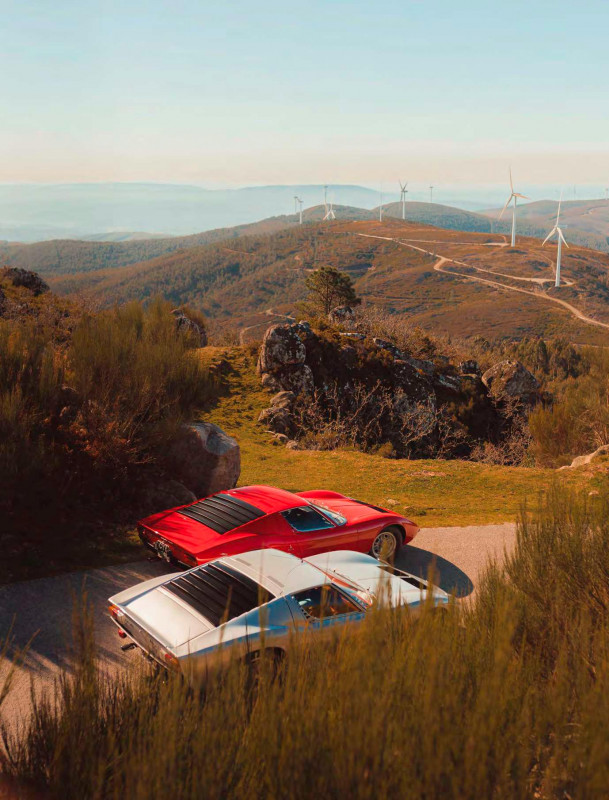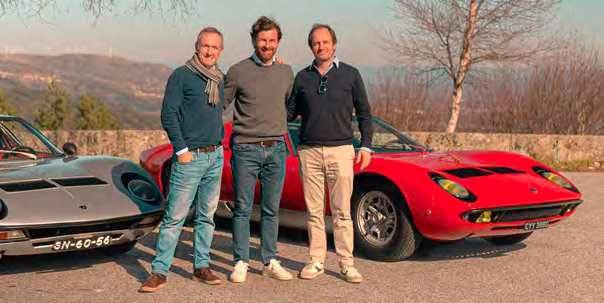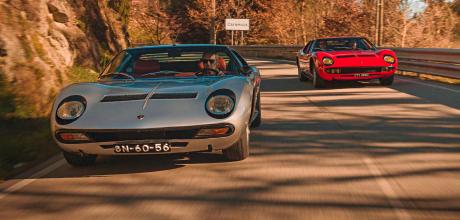Twin test Lamborghini Miura P400 S and SV go head to head in the mountains
Managing the Miura. Ground zero for supercars, the Miura is a true superstar. We drive an SV into the Portuguese mountains to join ex-Chelsea and Spurs manager André Villas-Boas in his P400 S.
Story by Hugo Reis
Images by Stephane Abrantes/Deep Spirit Media
Lamborghini Miura: SECRETS AND HIGHS OF AN ICON
LAMBORGHINI MIURA Twin test
P400 S and SV go head to head in the mountains

This escalated quickly. Just minutes after arriving at the remote Portuguese village of Caramulo, I’m grabbing the Miura SV’s wheel with the confident demeanour of a kid on his first day of school. In the corner of my eye, a second, scarlet Miura appears and I need inch-perfect placement if I want to avoid an embarrassing and extremely expensive ‘shoulder charge’. After all, the red Miura is being driven by the football manager, André Villas-Boas.

Seconds later, the snapper’s gesture says we should overtake the camera-car. André puts his foot down to take the lead, the sound of the V12 filling the hills. My eyes widen and my heart rate goes up a notch. I take a second to react before following him. I floor it, and through the rear-view mirror I can see the carbs open up to unleash a symphony, a sound that fills your body, a caffeine shot, a gateway to a parallel reality, a fantasy becoming real.

I wonder whether I should have written part of this piece yesterday, before letting myself become intoxicated by the experience, but what is a Miura if not a thrill machine? How to describe it properly if not from the heart?
Just looking at these two cars in this scenery is infectious. I can’t even avoid this most tired analogy: the Gandini-penned body looks like a silk dress over a voluptuous body. If there’s anything I feel reserved about, it’s the excess of delicacy: narrow rear wheels, ‘soft’ eyes with eyelashes, something a little too feminine. The SV addresses this to some extent: oversized rear wheels within flared arches, no eyelashes, more aggressive lights. Yet despite the Miura being described by so many as the most beautiful car ever made, Gandini himself remains less enthusiastic: “It’s far from being one of my most important projects because I wasn’t in it from day one, unlike what happened with the Countach.”

The Miura was, conceptually, a race car that would never be allowed to race. Ferruccio Lamborghini was a discerning businessman and not merely the impulsive character played in the fable of the ‘angry Ferrari owner offended by Enzo’ (an episode which Lamborghini test driver Bob Wallace was sure never happened). The Miura was an after-hours project that Ferruccio acknowledged and endorsed. His only rule was: “Everything except racing!”
The first challenge to do justice to Sant’Agata’s greatest hit is to switch your focus from outer beauty to technical qualities, the main attraction of course being the ‘heart’. If the quad-cam V12 engine – originally designed by Bizzarrini and then tamed by Stanzani – wasn’t a surprise, the layout was something special. It was a tight fit, but the engine was short enough to be mounted transversely. But Lamborghini had to produce its own gearbox, as there was none in the market that could be used. No one in the team had any experience designing gearboxes, but that didn’t stop them from building a very good one. The world had never seen a transverse V12 production car before, and realistically hasn’t seen another since.
The full story of the Miura’s gestation is told in a separate feature (see page 58) but suffice to say that all the masterpiece was really missing was a name. The chassis’ P400 designation referred to ‘posteriore’ (rearengine) and four-litre capacity, but it was a rather cold and lacklustre name for such a vibrant product. Some say the Miura name arose because of Ferruccio’s friendship with Don Eduardo Miura (creator of a fighting bull breed) while others, like Wallace, said it came from someone in Bertone’s marketing department. Whatever you wish to believe, one thing’s for sure: no car has ever had a better sounding name.
Everything was looking bright even before the car turned a wheel, and that would oddly be the biggest threat to the company. Everyone wanted a Miura: not just anonymous businessmen, but also celebrities such as Frank Sinatra, Miles Davis, Onassis, Gianfranco Innocenti and, later on, Rod Stewart, Elton John, Van Halen, Nicolas Cage, Jay Kay, René Arnoux, Jean Todt and, of course, André Villas-Boas.
Despite teething problems, the orders kept coming, because a car is never bad when you have nothing to compare it against. It was in league of its own. Even before Ferrari reacted with its 365 GT4 BB, Lamborghini had presented the P400 SV (Spinto Veloce) version, which Stanzani, Dallara and Wallace admitted was the Miura they had truly envisaged.
And that’s what I’m here to find out: how good is the Miura P400 S and its SV cousin? In isolation, André Villas-Boas’ Miura P400 S is a show-stopper. “I love and own several Italian cars,” the football coach tells me, “but I admit they’re moody. The Miura is very nice to use on the highway, comfortable enough and longgeared, so fairly relaxing.”
André’s car is 100% faithful to the original specification and has a Lamborghini Polo Storico certificate to prove it. It was originally sold in France – hence the yellow headlights, making a striking contrast with the Rosso Acrilico red paint which, in turn, goes superbly with the blue interior, despite not being the most obvious match.
The silver SV belongs to the Museu do Caramulo, a kind of spiritual retreat for petrolheads, hidden deep in the Portuguese mountains, reachable only by some of the best driving roads in Europe. Chassis #4852 is one of many Miuras that passed through the collection of the Emir of Qatar, Sheik Al-Thani. In 1989, João Lacerda, founder of the museum, bought it from a Swiss dealer and, as was his habit, drove it all the way home from Geneva to Caramulo. Dr Lacerda kept a little black book recording every outing. The first line reads: “26 September 1989. Arriving in Caramulo from Geneva.
About 3000km. 4 litres of oil. 14.5 litres of fuel per 100km at an average of 150km/h”. Then, a couple of lines below: “Back from Lisbon. Engine is impeccable, went at 200km/h for 66km.” Those were the days…
The factory-original black cloth interior was replaced at Sant’Agata 10 years later by gorgeous tobacco leather, along with the Borletti air conditioning. Where previous Miura versions had the ignition key, the SV has a St Christopher medal, which is usually absent in restored examples, but not in this one.
I close the SV’s door which, surprisingly, clicks smoothly, with a quality touch to it. Once inside, the driving position feels crazy because of the reach and height of the steering wheel. That said, it’s more spacious than I’d expected, and the pedals are very much in line with the seat (unusual for this sort of car). This side of a Lotus Europa, I can’t think of any other car with such a low seating position. Ahead, the view is striking through the deep, curved windscreen, the bulbous bonnet helping you picture how wide the car is.
The starter makes the deep noise you expect of something which must move a V12, which wakes almost silently, until the first serious blip of the throttle cleans its throat. Since Miuras don’t like idling for too long, up we go. The way the revs rise is more akin to a superbike than a car of this era: raucous, complex, yet tuneful. The clutch is heavy, for sure, but it’s very progressive and doesn’t need many revs on take-off. Peak torque comes at a rather high 5750rpm, but the SV weighs only 1293kg so it never feels slow. The gear selector is for firm wrists. Lamborghini began testing a hydraulic system to make it smoother, but it proved unreliable. Apart from that, the Miura is a very docile car when you’re driving at sensible speeds. Although the ride is firm by 1970s standards, it’s not uncomfortable and you could cruise all day if it weren’t for the minimalist seats.
The most surprising feature is the delicate, tight, fast and talkative steering, with all the feedback of a Porsche 911 but less noise. It’s a confidence-inspiring feature in a car which, otherwise, does everything to threaten your confidence. Like the brakes, which although have a tight pedal feel, aren’t man enough for 385hp.
Through the beautiful twists around Caramulo, the nose is fast and precise, without being nervous – and it must be, with 56% of the weight over the back wheels. The 255-section rear tyres are just big enough to stick the car to the road, and enough to discourage you finding its limits, because it feels like it would get a bit snappy. That’s something the Miura has in common with any mid-engined car of the era, because they were designed for clean driving, not the hooligan manners of today’s supercars. No one can save me from the Miura’s temper except myself. That said, the SV doesn’t feel menacing at all. The crystal-clear responses from the controls, the precision of its damping and the temptation to explore the outer limits of that glorious engine, invite me to risk more than I thought I would.
The one thing I can’t confirm around Caramulo is the quoted top speed of 180mph. But some of the road allows me to stretch the SV legs in fourth, so here we go. The engine is smooth, moderately torquey and deep-toned up to 3500rpm. From then on, it becomes serious, high-pitched, rushed, menacing. It revs happily beyond 6000rpm, something I never thought I’d be doing, but the engine feels so smooth and sound. There’s no way you can rush the gearchanges, though, because the lever takes its time across the gate. As with music, where silences need to be meticulously measured and relished, these little halts in the bull’s charge are to be respected. The metallic sound of the lever against the gate is strangely satisfying, and then the shove keeps coming, fiercely and consistently. No other car of this era does this.
Arriving at a pair of flowing curves, I downshift – a treat, thanks to the perfectly placed pedals and the enthusiastic reaction of the engine to every blip of the throttle. Every move is intense and demands attention, but it’s profoundly rewarding to achieve a harmony between your moves and the machine’s reactions. It’s not hard, as long as you don’t rush the interaction.
André and I are called to do some panning shots with the cars as close together and as fast as caution permits. Villas-Boas goes first. He’s not holding back much, as I need to floor the throttle to keep up. Engines echoing in the trees and walls, André’s car skimming the road surface ahead of me.
What a moment! We’re pushing on, charging down the hill. I glimpse André’s suspension compressing before he enters a right turn. I follow at the same speed and, as I feel the same compression on the SV, I sense the rear end twitching. It’s not a sideways moment, but enough to feel the weight transfer affecting my line, to the point that I instinctively turn the wheel straight.
When we stop, I’ve already decided not to reveal the chill down my spine. But then André gets out of his car, grins at me and shoots: “That sequence down there… scary stuff!” Feeling reassured I admit it: “I’m happy it wasn’t just me!” In his defence, I must point out that P400 S tyres are way narrower, but André is a much more experienced and talented driver than myself, having entered a great number of races, from two to four wheels, from Dakar to the WRC. A true gentleman driver of the modern age.
Anyway, the conclusion is the same: the Miura is not a car for beginners. It’s probably at eight-tenths that the chassis is truly in its element: when you can explore the engine almost completely, without overwhelming the brakes or tyres. But although it doesn’t feel natural to drive the Miura on the limit, it’s worth saying that it feels much more agile, poised and efficient than a traditional grand tourer. Any prejudice I’ve had based on its lack of racing pedigree, is already behind. The Miura never went racing, but racing went into the Miura.
At the end of the day, the videographer asks me if I can do a run up the hill to record the sounds. “Of course, my pleasure!” I reply. Up there, the skies are becoming orange, reflecting evocatively on the sculpted bonnet. The baritone delivers his solo, the thin-rimmed wheel tells my fingertips the story of each turn. Hands relax and the last sun rays warm my face. It’s this journey’s zenith – so perfect that it almost feels like a movie. The notes of On Days Like These inevitably come to mind, but this road is so much better than that from The Italian Job, and so is this Miura.
I can’t deny the feeling of relief as I turn off the engine for the last time, knowing everything went fine. I look at the Miura again, with serenity. Our relationship is platonic once more. The balance between the thrills suggested by the looks, and those the car actually delivers, are the essence of the supercar concept. The Miura gave birth to that concept over 55 years ago, and that will never go out of fashion.
Special thanks to André-Villas Boas (in centre below) and the Museu do Caramulo in Portugal. Silver SV feels like a more masculine version of Villas Boas’s red S. Miura is not an easy car to drive fast.
SPECIFICATIONS LAMBORGHINI MIURA P400 S MIURA P400 SV
- ENGINE: 3929cc V12 DOHC 3929cc V12 DOHC
- BORE X STROKE: 82mm x 62mm 82mm x 62mm
- COMPRESSION RATIO: 10.4:1 10.7:1
- INDUCTION: 4 x Weber 40IDL 3C 4 x Weber 40IDL 3L
- MAX POWER: 370hp at 7000rpm 385hp at 7850rpm
- MAX TORQUE: 383Nm (286 lb ft) at 5500rpm 388Nm (294lb ft) at 5000rpm
- TRANSMISSION: 5-speed manual, RWD 5-speed manual, RWD
- SUSPENSION: MacPherson struts, wishbones, coilover dampers and anti-roll bars front/rear
- TYRES: 215/70 R15 (front), 225/70 VR15 (rear) 215/70 VR15 (front), 225/60 WR15 (rear)
- DIMENSIONS: 4360mm (L), 1760mm (W), 1067mm (H) 4360mm (L), 1760mm (W), 1067mm (H)
- WEIGHT: 1200kg 1293kg
- MAX SPEED: 175mph 180mph
- 0-62MPH: 5.5sec 4.8sec
Driving on the limit can be a little unsettling. Gear changes and cornerning require concentration.
The way the V12’s revs rise is more akin to a superbike than a car of this era: raucous, complex, yet tuneful ”


